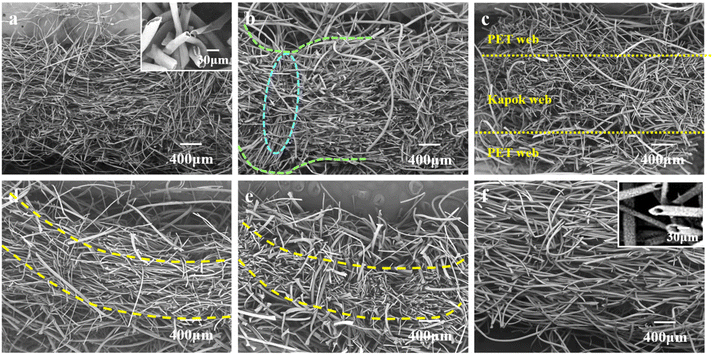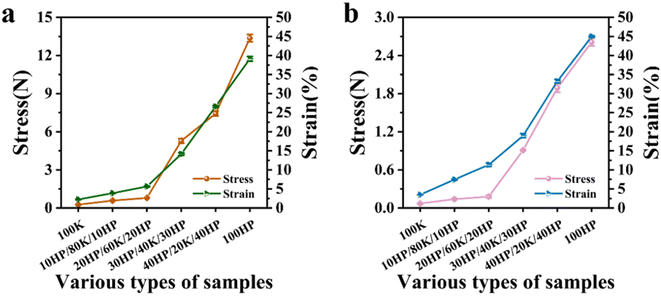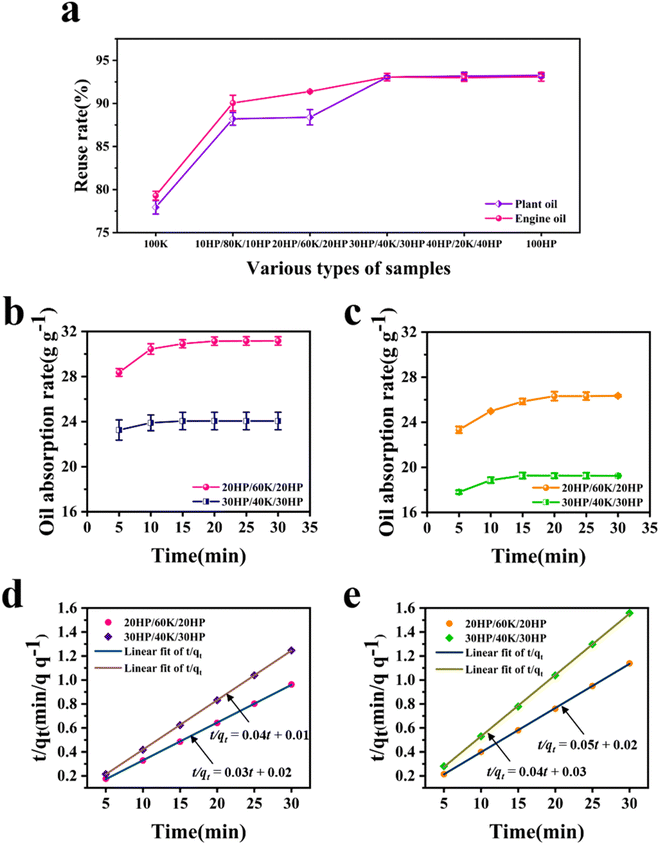 Open Access Article
Open Access ArticleHollow polyester/kapok/hollow polyester fiber-based needle punched nonwoven composite materials for rapid and efficient oil sorption
Yuxuan Zhou a,
Borong Zhua,
Ting Yanga,
Yuqing Liua,
Ke-Qin Zhang
a,
Borong Zhua,
Ting Yanga,
Yuqing Liua,
Ke-Qin Zhang *a and
Jinxin Liu
*a and
Jinxin Liu *ab
*ab
aCollege of Textile and Clothing Engineering, National Engineering Laboratory for Modern Silk, Soochow University, Suzhou 215123, China. E-mail: kqzhang@suda.edu.cn; jxliu@suda.edu.cn
bChina National Textile and Apparel Council Key Laboratory for Silk Functional Materials and Technology, Soochow University, Suzhou 215123, China
First published on 11th September 2023
Abstract
Nowadays oil pollution poses a serious threat to the environment and people's daily life. As reusable and environmentally friendly materials, fiber-based oil sorption materials can effectively alleviate this phenomenon. However, maintaining a high sorption rate along with improved mechanical properties remains a challenge for oil sorption materials. Herein, we report a novel hollow PET/kapok/hollow PET nonwoven with high porosity and oil retention, outstanding cyclic oil sorption rate and improved mechanical performance using kapok as the oil preserver and hollow PET as the conductor and structure enhancer. Benefiting from the three-layer composite structure fabricated by carding and needle punching reinforcement, the resulting oil sorption materials, with kapok proportion more than or equal to 60%, exhibited high oil sorption rate and oil sorption speed. The materials of 20HP/60K/20HP component content present a high initial oil sorption rate of 28.22 g g−1, a maximum oil sorption rate of 31.17 g g−1 and a sorption rate constant of the Quasi second-order kinetic equation of 0.067 in plant oil. On the other hand, when the proportion of kapok fiber in the material was below 60%, due to the introduction of hollow PET, the mechanical properties were significantly boosted, and its oil retention and reusability were distinguished, with a reuse rate stabilizing at a relatively high level (>93%) in plant oil after undergoing three oil sorption cycles. The successful fabrication of hollow PET/kapok/hollow PET nonwovens could provide a new approach for the design and development of oil sorption materials.
1. Introduction
The consumption of various oil resources is increasing significantly due to the development and production demands. However, this poses a serious threat to the environment and people's daily lives,1,2 specifically through kitchen oil pollution, industrial oil contamination, and oil leakage at sea. The result is destructive impacts on marine life, water resources, and land soil.3–5 Currently, oil pollution problems are typically tackled using methods such as dispersion, solidification, fencing, and sorption.6 The sorption method is a highly effective technique for quickly and efficiently absorbing oil.7–9 The outer surface of the oil sorption material quickly draws the oil into its interior, where it is subsequently absorbed and retained in the pores of the sorption medium. This not only treats the leaked oil, but also separates the water and oil, leading to oil recovery,10,11 making it an environmentally friendly and energy-efficient solution. Therefore, the development of an eco-friendly oil sorption material with a considerable level of strength has emerged as an urgent concern among researchers worldwide.Fiber-based oil sorption materials can reduce the negative impact of oil products on both people and the environment. These materials are low-priced, highly efficient, and environmental friendly.12 However, utilizing a single natural or chemical synthetic fiber material for fabricating the oil sorption materials, makes it challenging to achieve the necessary mechanical properties required and to meet the above-mentioned characteristics. Therefore, two types of fibers need to combined to maximize their individual advantages.13,14 Kapok fiber, as a natural material, is known for its high hollowness, which enables it to efficiently absorb and retain oil.15 Kapok fiber is non-toxic, as it does not pollute the ecosystem and has a high recovery rate.16–18 Synthetic fibers have also become popular material for oil sorption products due to low cost, effectiveness and recyclability.19–21 Among them, nonwoven fabrics made from hollow polyester fibers exhibit excellent performance. Ascribing to their large water contact angle, lipophilic and hydrophobic properties, hollow polyester fibers are capable of absorbing a large amount of oil. Furthermore, their high crystallinity and regular structure provide excellent mechanical properties, which enable the nonwovens to be reused multiple times.22 Consequently, if the material structure of natural fiber and synthetic fiber combination is used, it can not only enable the material to have good oil sorption performance, achieving the purpose of rapid oil sorption, but also boost the mechanical properties of the material.
Using natural fiber assemblies or blending them with synthetic fibers to absorb oil has become an efficient method to remove oil spills. Lim et al. studied the oil sorption capacity and hydrophobic–oleophilic characteristics of packed kapok assemblies. The results showed a high oil retention ability.23 Nevertheless, the assemblies offered low strength, which indicates that further research works are required to improve the strength of fiber-based nonwovens for oil spill removal.24 The preparation of nonwovens by blending various types of natural fibers was also attempted. Despite having a good oil sorption performance, the mechanical properties of the nonwovens were not enhanced.13 In a study by Lee et al., blending kapok and polypropylene (PP) fibers during carding was used to investigate the oil sorption capacity of needle-punched nonwovens. They found that the PP/kapok blend (50/50) sample exhibited the highest synergy effect, having the lowest bulk density and the best oil sorption capacity.24,25 This highlights the importance of the porosity of fibrous assembly to obtain high oil sorption capacity. However, a comprehensive study on the development of natural fiber nonwoven and hollow synthetic fiber nonwoven and their oil sorption capacities, tensile strength, and oil sorption rate has not yet been reported.
Oil sorption materials with excellent quality should possess the following characteristics: (1) good hydrophobic and lipophilic properties; (2) large surface morphology that increases the contact area with oil, thereby quickly absorbing oil into the interior and improving efficiency; (3) porous internal structure that provides sufficient oil storage space to expand oil sorption saturation; (4) certain mechanical strength that promotes reusability, environmental friendliness, and pollution-free properties.26–28 Based on these characteristics, we designed and fabricated the following oil sorption nonwoven materials.
In this work, kapok fiber and hollow polyester (PET) fiber are used as raw materials. Initially, kapok fiber web and hollow PET fiber web with varying surface densities are produced via combing and web forming technology. Next, a three-layer composite structure of hollow PET/kapok/hollow PET nonwovens is prepared through needle punching. The outer layer's hollow polyester fiber exhibits good hydrophobicity, lipophilicity, and liquid conductivity, while the middle layer's kapok fiber aids in oil sorption and preservation. The entire material is characterized by a high number of pores and cavities, contributing to the abundant oil sorption space. In addition, the unique peak-valley surface morphology formed by the penetration of the needle through three layers of materials enlarges the contact area between the oil absorbing material and oil stains. The needle-punched pores of the material are conducive to oil infiltration, making the material have good oil sorption ability and accelerating oil sorption and transmission performance. Needle-punched nonwovens exhibit superior reusability and oil retention compared to loose fiber assemblies.14 We conduct further research on the mechanical properties, initial oil sorption rate, cyclic oil sorption rate, reuse rate, and oil sorption saturation time of hollow PET/kapok/hollow PET nonwovens.
2. Experimental section
2.1 Materials
Hollow polyester (PET) fibers with an average diameter of 30 μm and an average length of 64 mm were provided by Huanqiu Cotton Co., Ltd (Cixi, Zhejiang, China). Kapok fibers with an average diameter of 18 μm and an average length of 25 mm were supplied by Weiyu Textile Company (Nanning, Guangxi, China).2.2 Fabrication of hollow PET/kapok/hollow PET nonwovens
Prior to the preparation of hollow PET/kapok/hollow PET nonwoven composite materials, hollow PET and kapok fiber web were initially produced separately via a mixed colour carding machine (FN300, Qingdao Textile Machinery Co., Ltd, Qingdao, Shandong, China). Specifically, polyester and kapok fibers of a certain mass were carded to form fiber webs (Fig. 1a). By controlling the feeding mass of the roller carding machine, five sets of hollow PET fiber web with different surface densities were prepared in this study, with feeding masses of 10, 20, 30, 40, and 100 g, respectively. Meanwhile, this study prepared 5 sets of kapok fiber web with different surface densities, with feeding masses of 100, 80, 60, 40, and 20 g, respectively. | ||
| Fig. 1 Schematic diagram of the (a) carding process, (b) needle punching process, and (c) hollow PET/kapok/hollow PET nonwovens. | ||
Needle punching was adopted as a reinforcement method to enhance the mechanical properties of hollow PET/kapok/hollow PET nonwovens. During this reinforcement process, the pre-needle density, pre-needle depth, and pre-needle speed was 130 needles cm−2, 8.6 mm, and 20.6 m min−1, respectively, while the main needle density, main needle depth, and main needle speed was 130 needles cm−2, 3.4 mm, and 0.78 m min−1, respectively. The fiber webs obtained from the mixed colour carding machine were fed into the needle punching machine (YBG343-110, Hairun Textile Machinery Co. Ltd, Yizheng, Jiangsu, China) for needle punching process (Fig. 1b). By combining and matching various grams of kapok and hollow PET fiber webs during needle punching, we have prepared 6 types of nonwoven composites materials, 100 g of kapok nonwovens (100K), 10/80/10 g hollow PET/kapok/hollow PET nonwovens (10HP/80K/10HP), 20/60/20 g hollow PET/kapok/hollow PET nonwovens (20HP/60K/20HP), 30/40/30 g hollow PET/kapok/hollow PET nonwovens (30HP/40K/30HP), 40/20/40 g hollow PET/kapok/hollow PET nonwovens (40HP/20K/40HP), and 100 g hollow PET nonwovens (100HP) (Fig. 1c).
2.3 Characterization
The surface and cross-sectional morphology of hollow PET/kapok/hollow PET nonwovens were examined by scanning electron microscopy (SEM; TM3030, Hitachi Ltd, Japan) after being sputter-coated with gold. It should be noted that in a gesture to prevent the damage to hollow PET/kapok/hollow PET nonwovens during the spraying process, the samples were sprayed with gold by decreasing the current and extending the spraying time. In the study, the gold spraying process was carried out two times, with each spraying time of 90 seconds and a spraying current of 2 mA.The diameters of hollow PET fibers and kapok fibers were obtained by measuring 100 fibers according to the SEM images, with the software Nano Measurer 1.2.5.
The contact angle was tested by the static drop method utilizing a contact angle tester (OCA15EC, Dataphysics, Germany). Take a long strip of hollow PET/kapok/hollow PET nonwovens sample and flatten it on both sides.
The mechanical properties of hollow PET/kapok/hollow PET nonwovens in both the machine direction (MD) and the cross direction (CD) were measured by an electronic strength tester (YG026Q, Ningbo Textile Instrument Co. Ltd, Ningbo, Zhejiang, China) using the strip method. The sample size, stretching speed, clamping distance, and pre-tension was 200 × 50 mm2, 200 mm min−1, 100 mm, and 1 N, respectively.
The oil sorption performance of hollow PET/kapok/hollow PET nonwovens was determined through oil sorption performance test. The test area of the sample is 5 × 5 cm2. Test each kind of sample 5 times and take the average value.
3. Results and discussion
In the application field of oil sorption materials, oil sorption nonwovens are commonly used in fields such as kitchen oil-absorbing paper, industrial oil pollution, marine oil leakage, etc. They play a dominant role in hydrophobic and fast oil sorption, and preferably can be reused to protect the environment. Accordingly, our study concentrates on the technical features of hollow PET/kapok/hollow PET nonwovens, such as hydrophilicity, mechanical properties, and oil sorption properties.3.1 Morphologies and structures of hollow PET/kapok/hollow PET nonwovens
Fig. 2 shows the optical surface morphology images of hollow PET/kapok/hollow PET nonwovens with varying ratios of hollow PET and kapok content. The appearance of kapok fiber is yellow (Fig. 2a), while the hollow PET fiber is white (Fig. 2f). As shown in Fig. 2, an increase in hollow PET proportion in the outer layer, causes the outer surface colour of nonwoven materials to gradually whiten. Fig. 3 illustrates that the holes among the fivers marked by yellow circles are needle marks caused by the needle punching process. As exhibited in Fig. 3a, we can observe that the kapok fibers are thin and narrow, which makes them easily flat, cracked, twisted, or folded along the axial direction. The arrangement of kapok fibers is non-uniform, and their average diameter is 18 μm. Fig. 3f reveals that the morphology of hollow PET fibers is full and regular in shape, smooth in appearance, and axially straight without twisting. In the case of the 10HP/80K/10HP sample, it is evident that hollow PET fiber web covers the kapok fiber web (Fig. 3b). With the increase in the proportion of hollow PET fibers, the evenness of the hollow PET/kapok/hollow PET nonwovens was also improved. The 30HP/40K/30HP sample demonstrates a degree of homogeneity that is similar to that of the 100HP sample (Fig. 3b–e).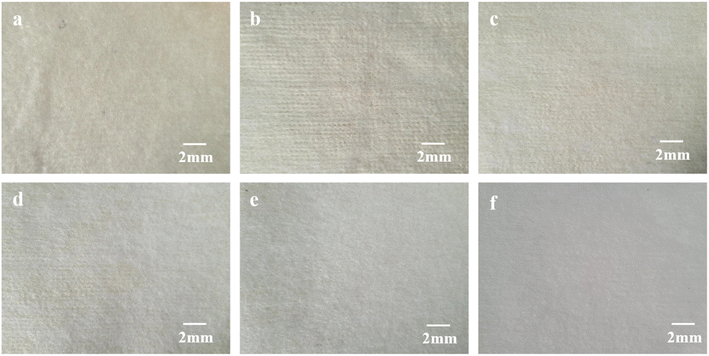 | ||
| Fig. 2 Surface morphology of various types of hollow PET/kapok/hollow PET nonwovens. Optical images of (a) 100K; (b) 10HP/80K/10HP; (c) 20HP/60K/20HP; (d) 30HP/40K/30HP; (e) 40HP/20K/40HP; (f) 100HP. | ||
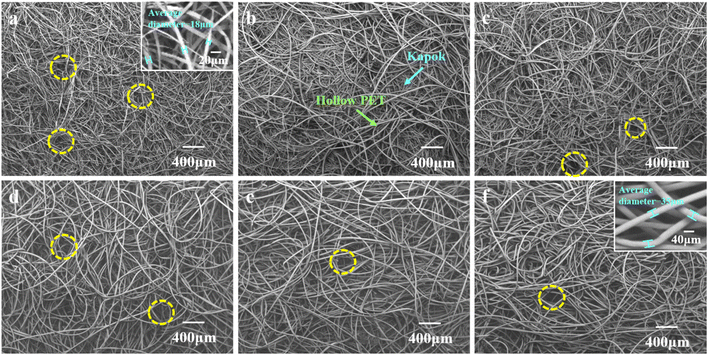 | ||
| Fig. 3 Surface morphology of various types of hollow PET/kapok/hollow PET nonwovens. SEM images of (a) 100K; (b) 10HP/80K/10HP; (c) 20HP/60K/20HP; (d) 30HP/40K/30HP; (e) 40HP/20K/40HP; (f) 100HP. | ||
Fig. 4 demonstrates cross-sectional SEM photos of hollow PET/kapok/hollow PET nonwovens with various ratios of hollow PET and kapok content. The cross-section fracture of kapok fiber exhibits an irregular flat round hollow structure, and it has buckling in the longitudinal direction (Fig. 4a). The structure of 100K sample is relatively loose, and the gap between fibers is larger, which may be ascribed to the fact that kapok fiber, as a natural fiber, is thin and soft and has a natural twist. The needle marks are perpendicular to the material surface in various types of hollow PET/kapok/hollow PET nonwovens (blue dashed lines in Fig. 4b) and the peak-valley structure is formed on the material surface caused by needle punching process (green dashed lines in Fig. 4b). As the proportion of hollow PET fibers increase, the layering effect becomes more apparent in the hollow PET/kapok/hollow PET nonwovens, and it becomes more evident in every layer of fiber web. Meanwhile, the hollow PET fiber web gets thicker while the kapok fiber web becomes thinner. Kapok fiber web is sandwiched between the top and bottom hollow PET fiber web (Fig. 4c–e). The overall structure of hollow PET/kapok/hollow PET nonwovens is more compact and solid. The hollow PET fiber has a regular circular cross-section, which is flat and smooth. The fiber wall is thicker, and the hollowness is slightly lower than that of kapok fiber. In hollow PET nonwovens (Fig. 4f), the gaps between hollow PET fibers are small, arranged neatly, but the structure of the sample is regular. This could be attributed to the great strength and shape retention of hollow PET fibers, resulting in even distribution after the carding process. Moreover, the structure of nonwoven material maintains in a relatively good condition under the action of needle punching force.
3.2 Mechanical properties of hollow PET/kapok/hollow PET nonwovens
Considering that oil sorption materials have certain requirements for strength, the mechanical properties of various types of hollow PET/kapok/hollow PET nonwovens were measured in both the machine direction (MD) and the cross direction (CD). As revealed in Fig. 5, the tensile stresses of hollow PET/kapok/hollow PET nonwovens in MD are 0.265, 0.585, 0.795, 5.28, 7.43, and 13.365 N, respectively, at concentrations of 100K, 10HP/80K/10HP, 20HP/60K/20HP, 30HP/40K/30HP, 40HP/20K/40HP, and 100HP, while the tensile stresses in CD are 0.07, 0.14, 0.18, 0.91, 1.89, and 2.61 N, respectively. The results illustrate that the tensile stress of hollow PET/kapok/hollow PET nonwovens increases proportionally with the amount of hollow PET. Previous morphology analyses suggest the improved mechanical properties can be attributed to the introduction of hollow PET, which is then strengthened by needle punching. The latter results in narrower gaps between fibers and an increase in van der Waals forces between them. Meanwhile, the strength of hollow PET as a synthetic fiber is significantly greater than that of kapok fiber. Gradually increased proportion of hollow PET boosts the thickness of the hollow PET fiber web, thus enhancing the mechanical properties of the material. Compared to the previously prepared nonwoven oil absorbing materials, the hollow PET/kapok/hollow PET nonwovens exhibit enhanced mechanical properties.13 The distribution of both kapok and hollow PET fibers is mostly random. However, the fibers trend to align more along the machine direction due the movement of the web curtain, which leads to a higher stress in MD. In contrast, the strain of CD is higher than that of MD. When the material is stretched, the main force applied to it is the adhesion force on the surface of the fibers. The distribution of fibers is more uniform in MD as compared to CD. MD also has higher fiber orientation, greater cohesion, and less slip.29 Therefore, the stress is stronger in MD and the strain is higher in CD.3.3 Oil sorption properties of hollow PET/kapok/hollow PET nonwovens
As shown in Fig. 6a, the contact angle between kapok nonwovens and water is 159.4°, demonstrating that kapok fiber is allergic to water and has good lipophilicity as well. Besides, the contact angle between hollow PET nonwovens and water is 123.1°, illustrating its superior hydrophobicity as well. Many researchers have reported that kapok fiber, similar to cotton fiber, mainly consists of 64% cellulose and 13% lignin.15,30,31 Moreover, kapok fiber contains a certain amount of oily wax on its surface and interior, which makes it more hydrophobic than cotton fiber.32 Bao et al. found that the sugar ring of cellulose is quite rigid, accounting for its hydrophobicity in the axial direction.33 Lignin has been proven to have longer alkyl groups (octyl).34 Owing to long molecular chains and a three-dimensional network structure, each functional group connected by neutral ether bonds and non-polar carbon–carbon bonds, lignin demonstrates good lipophilicity. Furthermore, lignin has been reported to reduce the permeability of water through plant cell walls.35 Hollow PET has no polar groups except for the terminal hydroxyl group, and contains fewer hydrophilic groups. It is a linear polymer with high crystallinity and orientation, which provide it with hydrophobic and lipophilic properties.36,37 The sorption power of a material comes from the van der Waals force between the material surface and the oil, the capillary force between fibers, and the capillary force within the fiber pore structure. The sorption power determines the oil sorption speed of the material.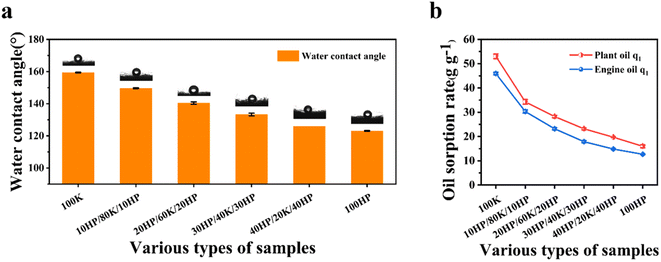 | ||
| Fig. 6 (a) Water contact angle of various types of samples, and (b) initial oil sorption rate of different kinds of samples in plant and engine oil. | ||
To investigate the oil sorption performance of six various types of hollow PET/kapok/hollow PET nonwovens, we tested their initial oil sorption rate q1, cyclic oil sorption rate qn, and reuse rate Rn.
Submerge the sample in oil for 5 minutes and remove it from the container. Transfer it onto a sieve and wait until any excess oil droplets have ceased to drip. Weigh the sample and sieve together after oil sorption, then compute the initial oil sorption rate q1 of the material. The initial oil sorption rate q1 is determined by the following formula:
Fig. 6b illustrates that when the ratio of the two fibers in hollow PET/kapok/hollow PET nonwovens is 100K, 10HP/80K/10HP, 20HP/60K/20HP, 30HP/40K/30HP, 40HP/20K/40HP, and 100HP, the initial oil sorption rate q1 in the plant oil experiment is 53.03, 34.28, 28.22, 23.18, 19.72, and 15.97 g g−1, respectively. The results above are obviously much superior to that of previously reported needle-punched nonwoven materials, which is also composed of natural fibers and synthetic fibers, which is almost three times the previous ones.25,38,39 As the hollow PET proportion increases, the kapok proportion decreases, and the corresponding water contact angle of hollow PET/kapok/hollow PET nonwovens drops, revealing that the hydrophobicity and lipophilicity of the material are becoming less significant (Fig. 6a). The q1 of hollow PET/kapok/hollow PET nonwovens slowly declines, exhibiting that its initial oil sorption performance gradually deteriorates. Due to the lower surface energy of kapok fibers, the adhesion of oil droplet molecules to the fiber surface is stronger, and the oil sorption performance is also superior.40,41 Moreover, the kapok density is smaller, so the q1 value of the 100K material is the highest during the initial oil sorption process. The oil storage space of a material determines its oil sorption saturation. The sorption process in this study includes both surface adsorption and internal absorption. Researchers have stated that in nonwoven materials that absorb oil, not only do oil adhere to the surface and intersection of the fibers, but also oil enters the internal pores of the fibers.42 In this study, the hollow PET/kapok/hollow PET nonwovens oil storage space is mainly composed of gaps between fibers, pores of kapok, and pores of hollow polyester. Kapok fiber has a fluffy texture in its natural state, with large gaps between fibers, and a fiber hollowness of up to 80–90%.43 Credited to its large oil storage space, it exhibits excellent oil sorption performance. The hollowness of hollow polyester is lower than that of kapok, and the oil storage space is relatively smaller. As a result, in the nonwoven materials fabricated in this study, the quantity and size of fiber pores and gaps between fibers provide a space for the material to absorb oil. The morphology, structure, and distribution of kapok and hollow PET fibers have profound impacts on the oil sorption saturation of hollow PET/kapok/hollow PET nonwovens. The introduction of hollow PET fibers occupies a portion of the oil sorption space between kapok fibers, reducing the porosity of hollow PET/kapok/hollow PET nonwovens. Additionally, the hollowness of hollow PET fibers is smaller than that of kapok fibers, resulting in a reduced oil sorption capacity. More importantly, the hydrophilicity of hollow PET fibers is lower than that of kapok fibers, causing a gradual reduction in the q1 value. With the climbing up of hollow PET proportion, the volume of kapok in the material decrease. Following the needle punching process, the gaps between kapok fibers are narrowed, and the fiber web becomes thinner, further affecting the oil sorption performance of the material, leading to a continuous decline in q1.
To compare with the oil sorption properties of hollow PET/kapok/hollow PET nonwovens in different kinds of oils, we also carried out sorption experiments in engine oil. The q1 values of six various types of hollow PET/kapok/hollow PET nonwovens are 45.93, 30.29, 23.18, 17.87, 14.84, and 12.68 g g−1, respectively, when absorbing engine oil. Considering the same type of hollow PET/kapok/hollow PET nonwovens, the q1 value for the plant oil experiment is significantly higher than that in the corresponding engine oil experiment, revealing that the sorption performance of this material is better for plant oil than for engine oil. This phenomenon may be ascribed to the fact that the plant wax lipid on the surface of kapok fiber mainly consists of long-chain alkanes, fatty acids, esters and other substances,44,45 but the engine oil belongs to mineral oil, which is mainly composed of fatty hydrocarbons,46 and the plant oil, as a substance composed of long-chain fatty acids and esters, has a more similar molecular structure with plant oil than mineral oil. Consequently, it is easy to form strong van der Waals forces and dispersion forces, enabling kapok to have a stronger sorption capacity for plant oil than engine oil.
In an effort to systematically evaluate the oil sorption performance of materials, we conducted multiple oil sorption experiments on hollow PET/kapok/hollow PET nonwovens. The samples after the initial oil sorption were wrung dry, and oil sorption tests were repeated three times to calculate the oil sorption rates q1, q2 and q3.
According to Fig. 7, as the number of oil sorption times increases, the cyclic oil sorption rates q2 and q3 of various types of hollow PET/kapok/hollow PET nonwovens in plant oil decrease to varying extents. The q values corresponding to 100K, 10HP/80K/10HP, 20HP/60K/20HP, 30HP/40K/30HP, 40HP/20K/40HP, and 100HP are reduced by 11.70, 4.04, 3.28, 1.61, 1.35, and 1.08 g g−1 after three oil sorption cycles, respectively. The difference in sample oil sorption rate q is decreasing, illustrating that the cyclic oil sorption performance is becoming more stable. This can be attributed to the twisted ribbon structure of kapok fibers, which can be easily squeezed and deformed due to their fragile texture. Kapok fibers demonstrate a low resilience and undergo irreversible deformation. After two or more uses and drying, the internal pores of the fibers decrease in size, the gaps between the fibers narrow, and the material structure becomes more compact, influencing its morphology, structure, and function in the long term. Therefore, higher kapok proportion results in a more significant decline in oil sorption rate in hollow PET/kapok/hollow PET nonwovens sorption. In the meantime, the residual oil in the previous drying cycle has effects on the oil sorption saturation in the next experiment to some extent, so the oil sorption rate measured in subsequent experiments differs dramatically from the q1 value. There is a slow decrease in the oil sorption rate drop of hollow PET/kapok/hollow PET nonwovens with the hollow PET proportion climbing up. This can be explained by the fact that as the proportion of hollow PET content grows up, the influence of its structure on material properties gradually becomes more dominant. Comprehensively speaking, the morphology and structure of hollow PET fibers are relatively better, so their distribution in the fiber web is more uniform, and the mechanical properties of the material are more outstanding after being carded by a carding machine. It can maintain a good structural shape in every oil sorption cycle. The gap size between fibers is also relatively even, and the difference in capillary forces formed between gaps is smaller, bringing about stable oil sorption performance of the material.
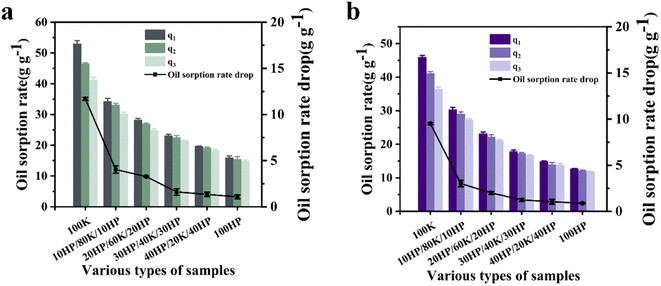 | ||
| Fig. 7 Circulating oil sorption rate q1, q2, q3 and oil sorption rate drop of various types of samples in (a) plant oil and in (b) engine oil. | ||
We also conduct sorption experiments on the samples in engine oil. From Fig. 7a and b, it can be seen that when absorbing plant oil, the q3 values for six types of hollow PET/kapok/hollow PET nonwovens are 41.33, 30.24, 24.94, 21.57, 18.38, and 14.89 g g−1, respectively. When absorbing engine oil, the corresponding q3 is 36.42, 27.29, 21.19, 16.63, 13.81, and 11.80 g g−1, and the corresponding oil sorption rate drop is 9.51, 3.01, 1.99, 1.24, 1.04, and 0.88 g g−1, respectively. These data above can be analyzed that for the same type of hollow PET/kapok/hollow PET nonwovens with the same polyester and kapok content, the q3 in the engine oil experiment is obviously lower than that in the plant oil experiment. Meanwhile, the oil sorption rate drop when absorbing engine oil is lower compared to the corresponding plant oil experiment. The results indicate that while the material has superior sorption performance for plant oil, its sorption stability and oil retention for engine oil are greater than that of the material for plant oil. The difference in the sorption rate of hollow PET/kapok/hollow PET nonwovens for plant oil and engine oil is mainly due to the variation in viscosity between the two oils. The engine oil viscosity is higher, together with good sorption and adhesion properties for fibers. There is residual oil that cannot be discharged during each drying cycle, resulting in a less oil storage space for the material. Thus, the oil sorption rate drop is correspondingly smaller.
In a bid to further measure the reusability of materials, we introduce the concept of reuse rate Rn. This Rn rate is defined as the percentage of oil sorption saturation rate of the oil absorbing materials when they have been used multiple times, compared to their sorption rate when they are initially used:
Based on the experimental research above, the curves of the R3 of various types of hollow PET/kapok/hollow PET nonwovens were obtained (Fig. 8a). In plant oil, when the proportion of each component in hollow PET/kapok/hollow PET nonwovens is 100K, 10HP/80K/10HP, 20HP/60K/20HP, 30HP/40K/30HP, 40HP/20K/40HP, and 100HP, their R3 is 77.94, 88.21, 88.39, 93.05, 93.18, and 93.25%, respectively, after undergoing three oil sorption cycles; while the corresponding R3 in engine oil is 79.29, 90.05, 91.39, 93.06, 93.00, and 93.09%, respectively. In the cyclic oil sorption experiments conducted with both oils, we can clearly observe that the R3 of 100K in the sample is the lowest, while the R3 of hollow PET/kapok/hollow PET nonwovens slightly increased with the falling down of kapok proportion. When the component proportion is 20HP/60K/20HP, the reuse rate in plant oil is 88.39%, and the reuse rate in engine oil is 91.39%. The R3 value stabilizes at a relatively high level (>93%) in both plant oil and engine oil when the component reaches a proportion of 30HP/40K/30HP. During the experiment, the structure of 100K was damaged after the initial oil sorption, rendering it unable to maintain its initial morphology. Consequently, the subsequent oil sorption cycled led to fiber separation and fragmentation, significantly affecting the material's performance and reducing its reuse rate. Because of the decrease of kapok fiber proportion, the impact of its structural changes of materials on the oil sorption performance becomes slighter. In addition, attributing to the excellent elastic recovery of hollow PET, it suffers less damage during multiple cycles of oil sorption experiments and always maintains good structure and function. Therefore, the R3 increases, which illustrates that the oil sorption stability of hollow PET/kapok/hollow PET nonwovens material has been improved, with good oil retention and enhanced reusability. Investigations in reusability were also carried out in previous studies. However, it is reported that the relatively good results of reuse rate were no more than 75% after undergoing three oil sorption cycles.23,47
When the proportion of each component in the sample is 20HP/60K/20HP, its reuse rate is still in the rising stage. Nonetheless, when the proportion of each component reaches 30HP/40K/30HP and beyond, its reuse rate stabilizes in both experiments and remains largely unchanged. This indicates that, the material has achieved oil sorption saturation. In order to further investigate the relationship between the oil sorption saturation rate and the oil sorption time of hollow PET/kapok/hollow PET nonwovens, two sets of samples, namely 20HP/60K/20HP and 30HP/40K/30HP, are selected for oil sorption saturation testing. To perform the experiment, the sample must be immersed in the absorbed oil. After immersing the sample in oil, it should be removed using tweezers every five minutes and placed on a sieve. The sample should be left until there are no excess oil droplets before proceeding to weigh it. Compare the oil sorption rate of the sample at each oil sorption time. If the oil sorption rate of the sample at a given time is equal to the rate at the previous time, it suggests that the sample has reached saturation point. At this time, the oil sorption rate is the oil sorption saturation rate of the sample, and the previous moment is the oil sorption saturation time of the sample.
In the plant oil experiment, the oil sorption saturation rate of sample 20HP/60K/20HP is 31.17 g g−1, while the oil sorption saturation rate of sample 30HP/40K/30HP is 24.06 g g−1. Meanwhile, in the engine oil experiment, the oil sorption saturation rate of sample 20HP/60K/20HP is 26.32 g g−1, while the oil sorption saturation rate of sample 30HP/40K/30HP was 19.27 g g−1. This means, similar to the results obtained in the previous experiment, the overall sorption performance of the sample on plant oil is significantly better than that on engine oil. At the same time, the oil sorption rate of 20HP/60K/20HP is significantly higher than that of 30HP/40K/30HP. We can analyze from Fig. 8b and c that although the oil sorption performance of each group of samples differs in the experiments using the two types of oils, the variation pattern of the oil sorption rate values remains consistent. Specifically, the slope in the figure represents the oil sorption rate of the sample. It can be seen that the slope gradually declines and tends to zero around 20 minutes, revealing that the oil sorption rate q of 20HP/60K/20HP continues to climb up in the initial 15 minutes. During this period, due to the large oil sorption power and sufficient storage space, the oil sorption rate grows up rapidly. In spite of that, as time goes on, the growth rate of oil sorption speed slowly decreases, reaching saturation at 20 minutes, which represents the maximum oil sorption rate. The other group of samples, 30HP/40K/30HP, demonstrates a rapid increase in oil sorption rate within 10 minutes, followed by a decline in the growth rate of that oil sorption rate within 10–15 minutes. It reaches maximum oil sorption rate saturation at approximately 15 minutes. We can conclude that the oil sorption saturation time of 30HP/40K/30HP is shorter than that of 20HP/60K/20HP. With relatively less kapok fiber proportion in 30HP/40K/30HP, the internal pores of the fibers are reduced, and the gaps between the fibers are narrowed. As a consequence, the materials oil storage space is much less than that in 20HP/60K/20HP, causing earlier saturation.
Oil sorption speed is an indicator of the speed at which the material absorbs oil, while sorption kinetics is a theoretical study of the relationship between sorption speed and time during the sorption process. To clarify the sorption mechanism, a Quasi second-order kinetic model is adopted to analyze the oil sorption speed of materials in this study. The Quasi second-order kinetic model was proposed by Ho and McKay, and its expression is:
The oil sorption processes of 20HP/60K/20HP and 30HP/40K/30HP are analyzed by using a Quasi second-order kinetic model. Fig. 8d and e are scatter plots and fitting linear equations obtained by integrating the Quasi second-order kinetic equation and using t/qt to represent time t. It is evident from the results that there exists a linear relationship between t and t/qt, and the experimental data agrees with the Quasi second-order kinetic model. This suggests that the Quasi second-order kinetic model can be used to describe the oil sorption process of hollow PET/kapok/hollow PET nonwovens. In plant oil, the slope of t/qt of 20HP/60K/20HP is smaller than that of 30HP/40K/30HP, and its k2 is 0.067, less than 0.28 of 30HP/40K/30HP, which means that it has a higher sorption speed for plant oil. The results obtained from data analysis in engine oil are similar to this.
4. Conclusions
In summary, kapok fiber web and hollow polyester fiber web were successfully fabricated via a colour mixing carding technology. Needle punching reinforcement enabled the materials to form a three-layer composite structure, contributing to a high initial oil sorption rate, excellent cyclic oil sorption rate and reuse rate. In addition, with the introduction of hollow PET, the materials are endowed with enhanced mechanical properties, which can satisfy the requirements of oil sorption materials for reducing consumption and prolonging service life. When the proportion of kapok fiber in the material is greater than or equal to 60%, its oil sorption rate is higher and the oil sorption speed is faster. The materials of 20HP/60K/20HP component content present an initial oil sorption rate of 28.22 g g−1, a maximum oil sorption rate of 31.17 g g−1 and a sorption rate constant of the Quasi second-order kinetic equation of 0.067 in plant oil. While when the proportion of kapok fiber in the material is below 60%, credited to the introduction of hollow PET, its mechanical properties are significantly boosted, and its oil retention and reusability are outstanding, with a reuse rate stabilizing at a relatively high level (>93%) in plant oil after undergoing three oil sorption cycles. Demonstrating its rapid and sufficient oil sorption capacity, the hollow PET/kapok/hollow PET nonwovens are expected to have a wider range of applications in the field of oil sorption.Author contributions
Yuxuan Zhou: conceptualization, methodology, visualization, formal analysis, data curation, investigation, writing – original draft. Borong Zhu: visualization, investigation. Ting Yang: visualization, investigation. Yuqing Liu: visualization. Ke-Qin Zhang: visualization, supervision, writing – review & editing. Jinxin Liu: funding acquisition, supervision, writing – review & editing.Conflicts of interest
There are no conflicts to declare.Acknowledgements
This research was supported by the Opening Project of China National Textile and Apparel Council Key Laboratory for Silk Functional Materials and Technology, Soochow University (SDHY2131), Jiangsu Province University Natural Science Research General Project (21KJD540003), and Priority Academic Program Development of Jiangsu Higher Education Institutions (PAPD).Notes and references
- J. Beyer, H. C. Trannum, T. Bakke, P. V. Hodson and T. K. Collier, Mar. Pollut. Bull., 2016, 110, 28–51 CrossRef CAS.
- M. Ramanathan and S. B. Darling, Polym. Int., 2013, 62, 1123–1134 CrossRef CAS.
- H. Gao, M. Wu, H. Liu, Y. Xu and Z. Liu, Environ. Pollut., 2022, 293, 118511 CrossRef CAS PubMed.
- I. Radelyuk, K. Tussupova, J. J. Klemeš and K. M. Persson, J. Cleaner Prod., 2021, 302, 126987 CrossRef CAS.
- Y. Zhou, Q. Kong, X. Zhao, Z. Lin and H. Zhang, Environ. Pollut., 2022, 307, 119496 CrossRef CAS.
- A. L. Rodd, M. A. Creighton, C. A. Vaslet, J. R. Rangel-Mendez, R. H. Hurt and A. B. Kane, Environ. Sci. Technol., 2014, 48, 6419–6427 CrossRef CAS PubMed.
- X. Zhou, Z. Zhang, X. Xu, X. Men and X. Zhu, Ind. Eng. Chem. Res., 2013, 52, 9411–9416 CrossRef CAS.
- S. Ibrahim, S. Wang and H. M. Ang, Biochem. Eng. J., 2010, 49, 78–83 CrossRef CAS.
- M. A. Hubbe, O. J. Rojas, M. Fingas and B. S. Gupta, Bioresources, 2013, 8, 3038–3097 Search PubMed.
- J. Kang, H. Kim and C. Nam, J. Hazard. Mater., 2023, 445, 130559 CrossRef CAS PubMed.
- R. S. Rengasamy, D. Das and C. Praba Karan, J. Hazard. Mater., 2011, 186, 526–532 CrossRef CAS PubMed.
- R. Wahi, L. A. Chuah, T. S. Y. Choong, Z. Ngaini and M. M. Nourouzi, Sep. Purif. Technol., 2013, 113, 51–63 CrossRef CAS.
- C. J. Singh, S. Mukhopadhyay and R. S. Rengasamy, Ind. Crops Prod., 2023, 191, 115939 CrossRef CAS.
- S. Renuka, R. S. Rengasamy and D. Das, J. Ind. Text., 2015, 46, 1121–1143 CrossRef.
- M. A. Abdullah, A. U. Rahmah and Z. Man, J. Hazard. Mater., 2010, 177, 683–691 CrossRef CAS PubMed.
- N. Ali, M. El-Harbawi, A. A. Jabal and C. Y. Yin, Environ. Technol., 2012, 33, 481–486 CrossRef CAS PubMed.
- T. Dong, F. Wang and G. Xu, Ind. Crops Prod., 2014, 61, 325–330 CrossRef CAS.
- T.-T. Lim and X. Huang, J. Hazard. Mater., 2006, 137, 820–826 CrossRef CAS PubMed.
- L. M. T. M. Oliveira, J. Saleem, A. Bazargan, J. L. d. S. Duarte, G. McKay and L. Meili, J. Hazard. Mater., 2021, 407, 124842 CrossRef CAS PubMed.
- H. J. Kim, S. W. Han, J. H. Kim, H. O. Seo and Y. D. Kim, Curr. Appl. Phys., 2018, 18, 369–376 CrossRef.
- Z. Wang, H. Ma, B. Chu and B. S. Hsiao, Sep. Sci. Technol., 2017, 52, 221–227 CrossRef CAS.
- N. Billon, Polymer, 2023, 227, 125953 CrossRef.
- T.-T. Lim and X. Huang, Chemosphere, 2007, 66, 955–963 CrossRef CAS.
- H. M. Choi and R. M. Cloud, Environ. Sci. Technol., 1992, 26, 772–776 CrossRef CAS.
- Y.-H. Lee, J.-S. Kim, D.-H. Kim, M.-S. Shin, Y.-J. Jung, D.-J. Lee and H. D. Kim, Environ. Technol., 2013, 34, 3169–3175 CrossRef CAS.
- D. Ceylan, S. Dogu, B. Karacik, S. D. Yakan, O. S. Okay and O. Okay, Environ. Sci. Technol., 2009, 43, 3846–3852 CrossRef CAS PubMed.
- M. J. Akanbi, S. N. Jayasinghe and A. Wojcik, Polymer, 2021, 212, 123129 CrossRef CAS.
- S. Darvish Pour-Mogahi, Z. Ansari-Asl and E. Darabpour, Inorg. Chem. Commun., 2021, 133, 108945 CrossRef CAS.
- A. Rohatgi, J. P. Thomas, J. N. Baucom, W. R. Pogue, L. B. Cerully, D. M. Ebenstein and K. J. Wahl, Scr. Mater., 2008, 58, 25–28 CrossRef CAS.
- B. M. Dauda and E. G. Kolawole, Indian J. Fibre Text. Res., 2003, 28, 147–149 CAS.
- D. Fengel and M. Przyklenk, Chemical Investigation, Holzforschung, 1986, 40, 325–330 CrossRef CAS.
- T.-T. Lim and X. Huang, Ind. Crops Prod., 2007, 26, 125–134 CrossRef CAS.
- Y. Bao, H.-j. Qian, Z.-y. Lu and S. Cui, Macromolecules, 2015, 48, 3685–3690 CrossRef CAS.
- M. Yu, D. Mishra, Z. Cui, X. Wang and Q. Lu, Composites, Part B, 2021, 216, 108884 CrossRef CAS.
- P. Cinelli, I. Anguillesi and A. Lazzeri, Eur. Polym. J., 2013, 49, 1174–1184 CrossRef CAS.
- N. P. Prorokova, T. Y. U. Kumeeva, D. P. Kiryukhin, G. A. Kichigina and P. P. Kushch, Prog. Org. Coat., 2020, 139, 105485 CrossRef CAS.
- A. Raheem, Z. Zainon Noor, A. Hassan, M. K. Abd Hamid, S. Samsudin and A. Sabeen, J. Cleaner Prod., 2019, 225, 4 CrossRef.
- M. O. Adebajo, R. L. Frost, J. T. Kloprogge, O. Carmody and S. Kokot, J. Porous Mater., 2003, 10, 159–170 CrossRef CAS.
- S. Viju, R. S. Rengasamy, G. Thilagavathi, C. J. Singh and H. A. K. Mohamed, J. Nat. Fibers, 2022, 19, 4082–4092 CrossRef CAS.
- S. S. Z. Hindi, Int. J. Sci. Eng. Invest., 2013, 2, 89–96 Search PubMed.
- T. Dong, G. Xu and F. Wang, J. Hazard. Mater., 2015, 296, 101–111 CrossRef CAS PubMed.
- Y. Cui, G. Xu and Y. Liu, J. Ind. Text., 2012, 43, 330–337 CrossRef.
- J. G. Cook, Handbook of Textile Fibres, Merrow Publishing Co.Ltd, Watford, 1984 Search PubMed.
- H. M. Choi, J. Environ. Sci. Health, Part A: Environ. Sci. Eng., 1996, 31, 1441–1457 Search PubMed.
- H.-M. Choi, H.-J. Kwon and J. P. Moreau, Text. Res. J., 1993, 63, 211–218 CrossRef.
- M. He, Z. Wang, M. J. Moldowan and K. Peters, Org. Geochem., 2022, 163, 104331 CrossRef CAS.
- V. Subramoniapillai and G. Thilagavathi, Res. J. Text. Apparel, 2021, 25, 158–169 CrossRef CAS.
- E. I. Ugwu, A. Othmani and C. C. Nnaji, Int. J. Environ. Sci. Technol., 2022, 19, 8061–8084 CrossRef CAS.
| This journal is © The Royal Society of Chemistry 2023 |

